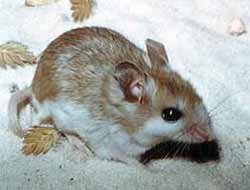
Anastasia Island Beach Mouse (Peromyscus polionotus phasma)Going . . . going . . . gone?
"As you might imagine, mouse conservation is not high on everybody's priority list", said Stephen Humphrey, a researcher at the Florida Museum of Natural History in Gainesville. But, if people do not concern themselves with the Anastasia beach mouse, this tiny, timid, and endangered critter of the beach dunes will be gone.
The Atlantic coast of Florida originally supported three subspecies of beach mouse-the pallid beach mouse of Flagler and Volusia Counties (already extinct by 1978), the southeastern beach mouse of the central Florida coast, and the Anastasia Island beach mouse of St. Johns County beaches.
These are all related to the oldfield mouse (P. polionotus) of the southeastern United States, but they, like similar beach mice along the Gulf coast, became trapped on barrier islands as the sea level rose at the end of the last ice age (10,000 - 12,000 years ago) and thus were genetically cut off from other oldfield mice. Gradually, each of these isolated populations became its own subspecies with specific genetic makeup and characteristics.
Looking like balls of cotton with big, dark eyes, the Anastasia Island beach mice inhabit the edges of the dunes, spending their days in burrows and nights roaming the dune area looking for food.
Although once found all along Anastasia Island, increased development in recent years has fragmented their habitat. Intense use by vehicles and pedestrians as well as storms has damaged or destroyed many of the sand dunes where the grasses, whose seeds the mice depend upon for food, grow. Increased population has also brought with it free roaming house cats and house mice that invade the remaining habitat and prey on the beach mice.
By 1986 the Anastasia Island beach mouse was found only at the island's two protected beach areas, Anastasia State Recreation area at the north end of the island, and Fort Matanzas National Monument fifteen miles away at the south end.
In 1992 a third population was established at Guana River State Park, a wild area on the beach about twelve miles north of St. Augustine, using healthy breeding pairs from the other two sites.
All three populations are currently stable, but increased human population, habitat destruction, or an environmental disaster could tip the balance, and the Anastasia Island beach mouse could join its southern relative in extinction and be lost forever.
Enjoy the beach, but please stay off the dunes-- Help protect the endangered Anastasia Island Beach Mouse. Help protect all wildlife-- Keep your dogs and cats indoors or on a leash.
|
Last updated: January 1, 2025
